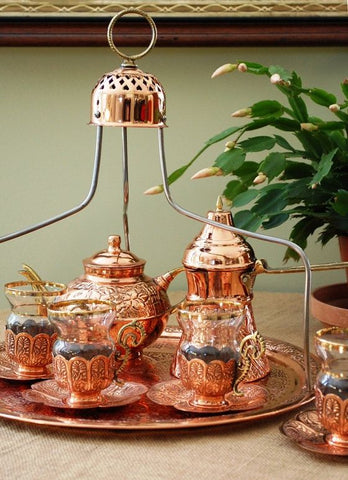Most popular during the Ottoman empire in Turkey, the traditional Turkish serving tray can be described as an innovative product ahead of its time.
So, what is the Turkish Tepsi tray?
These serving trays are traditional to the Turkish culture and most often associated with serving mainly tea and coffee however, they are also widely used to serve food.

The tray is designed in a tripodal fashion to enable ease of use whilst carrying items on it. It uses centripetal force which helps to reduce the chance of spilling any food and drink being carried.
The trays are made from metals, often stainless steel and copper, and are mostly circular in shape. Some of the trays are luxurious in style as they are often used as ornaments for the home. It is known that the Turkish tray can double up as a decorative feature as the hook allows it to be hung and used for other items such as displaying candles.
As you can see in the video below, the tray can be used to flaunt some cool tricks showcasing the centripetal force element!
How does it differ to the Tipsi Tray?
Visually, our Tipsi Tray appears similar in structure to the Turkish Tepsi tray.


The long handle is a key feature which makes the two trays appear very similar. Both trays allow for the plate / tray to be used on its own as a platter for serving food as the hook and arms are removable. Perhaps one of the main differences between the trays is the modern design work that comes with the Tipsi Tray. The Tipsi Tray features raised edges and a non-skid surface for keeping dishes securely in place to minimise spills and messes. The strong, but non plastic, rubber makes it almost impossible to spill anything over on the tray. By choosing rubber, it also makes the Tipsi Tray dishwasher friendly unlike the Turkish counterpart (a must have for the average 21st century user!)
Why is the Turkish Tepsi tray not widely used?
Although both have similar functionality, it is perhaps the user orientated focus for the Tipsi Tray that makes it a more universal product than the traditional Tepsi. The Tipsi Tray has been designed with the less able in mind, and therefore can offer certain features the Turkish Tepsi cannot. The Turkish Tepsi Tray is antiquated and only truly fit for use in Turkish coffee houses. The simplistic and elegant design of the Tipsi Tray make it a far more suitable companion in a contemporary setting.
Overall, the Tipsi Tray is a modern and practical tray which focuses on helping those able, and less able to live life a little easier!


Check out the Tipsi Tray here




1 Reply to "The Origins of the Turkish Tepsi Tray"
Personally, I would have preferred the use of silicone in place of rubber. Silicone has a high friction ratio, possibly better than rubber. Plus, silicone will withstand high temperatures better than rubber as well withstanding wear-and-tear. You might look at this and keep the cost difference in mind.
Just a thought!
Leave a Reply